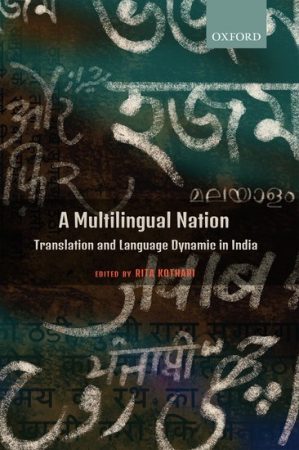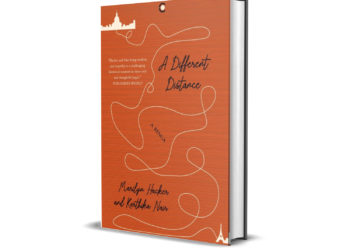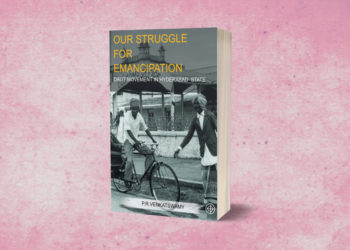Modern language ideologies firmly believe that languages ‘belong’ to specific communities, be they ethnic, regional, or religious. These imagined communities, according to Benedict Anderson (1991), get simultaneously projected into the past, present, and the future. In the late nineteenth and early twentieth centuries, the slogan ‘Hindi-Hindu-Hindustan’ projected Hindi (in the Nagari script) as
the language of the Hindus in north India ‘from the beginning’, urged contemporary north Indian Hindus to embrace it, and claimed that Hindi was the only language that could become the national language of all Indians, who were explicitly coded as Hindus.1
This modern imagination forged a continuum of script–language–community in the face of long histories of multi-scriptural and multilingual practices in which languages had commonly been written in more than one script and people learnt more than one language and knew how to navigate a multilingual social world.2
As the other chapters in this volume make clear, multilingualism in India has not been exclusive to literate elites or embodied in specialists, but has permeated every aspect of the social world—from endogamous families to the workings of the bazaar, from local and higher-level administration to the law, and from religious preaching to singing and storytelling (Orsini and Schofield 2015). It is flying in the face of this persistent multilingualism that modern language ideologies have carved out separate pasts and futures.
Entrenched notions of script–language–community produce their own contradictory expectations.
For one thing, if language ‘belongs’ to a community, when others use it they are ‘borrowing’ it, with the result that one ends up being endlessly surprised that such ‘borrowing’ is so extensive, repeated, and regular! Utterances, too, ‘belong’ originally to a speaker or community, and others ‘borrow’, ‘appropriate’, or ‘distort’ them.
At the same time, Harish Trivedi has argued that contrary to expectations that the long-standing multilingualism in India would have produced a robust translation culture, ‘there is, astonishingly, no evidence of any text of any kind having been having been translated into an Indian language’. Translations were not necessary, he claims, ‘probably because the major Indian languages were all mutually intelligible’ (2006: 196).3 Trivedi’s argument is overstated and does not seem to take Indian Muslims or Jains (or Persian-knowing Hindus) and their translation activities into account. Translations of scientific and technical texts (śāstras) or of religious texts were not uncommon—as a growing scholarship has shown.4
Nor does the comparative absence of poetic translations need be interpreted as a sign of complete intelligibility between Indian languages or as indifference towards other cultures as Trivedi suggests.
Rather, in early modern India to read or learn poetry by heart, to be an educated person, meant to know poetry in its own language. As a result, within the multilingual literary culture of India the cultivation of poetic tastes in different language traditions did not produce formal translation traffic but rather parallel enjoyment, poetic and conceptual equivalences, the insertion of tropes, symbols, and key terms and expressions from one poetic idiom into another, and in some cases mixed-language verses all part of what we can call ‘language stretching’.5 This evidence of considerable poetic traffic without formal translation fits well with a more ‘dialogic’ understanding of language.
Bhakha and Circulation
What happens if we think of language as not belonging to a particular community but rather, in the spirit of Mikhail Bakhtin’s philosophy of language, as socially shared, containing a multitude of ‘languages of various epochs and periods of socio-ideological life’ (1922: 291), with utterances constantly accented and re-accented depending on one’s position and audience? What happens if we take seriously Bakhtin’s contention that ‘at any given moment of its historical existence, language is heteroglot from top to bottom’ and that ‘languages do not exclude each other, but rather intersect with each other in many different ways’ (1992: 291) in the context of multilingual north India?6
In north India in the early modern period, several high languages (such as Sanskrit, Persian, and Arabic) coexisted not only in writing, but also in aural genres such as preaching and exposition, with a less differentiated bhakha or hindi/hindui/hindavi that was written in a variety of scripts and encompassed both local speech varieties and more supra-regional koines, whether literary Brajbhasha or the ‘mixed’ language of the sadhus and sants
(see Orsini 2012).7
If we think of languages as necessarily dialogic and intersecting each other in different ways, and of people as having differential grasp but frequent access to performance and written traditions in multiple languages, we stop thinking in terms of ‘original’ and ‘imitation’, or of ‘belonging’ and ‘borrowing’ and rather think in terms of accenting and re-accenting, of dialogue and audiences. And instead of expecting to see language circulating through channels of formal translation, we shift our attention to the registers and traces within languages that provide evidence of how words, expressions, ideas, tropes, and tastes actually circulated within this multilingual society. This is not to say that formal translation was completely absent or irrelevant in India, but that it occurred under specific circumstances (d’Hubert 2010; Cort 2015), and that it pales in volume before the constant informal traffic between languages and repertoires (Kothari 2015a, 2015b).
In this chapter, I focus on one specific utterance—Na Turk, Na Hindu—and follow its circulation across different religious and linguistic contexts in early modern north India as an example of informal translation and of accenting and re-accenting according to specific audience and context of discourse. While the rejection of at least certain aspects of formal religious identities is undeniable in this utterance, its repeated occurrence shows the shared and circula-tory nature of language in this social world, while the utterance itself took specific meanings, depending on the context of discourse and the intended audience.
Liminality, Syncretism, and Borrowing in Religious Terms and Spaces
‘Transferring themes and symbols from one religious sphere to another has long been well-attested practice in South Asia,’ notes Denis Matringe (1992: 190). Terms like brahma, karma, śūnya, or notions about the yogic body have been endlessly re-accented; there is nothing unusual about it. Yet, when the transfer happens between ‘Hindu’ and ‘Islamic’ spheres, it gets immediately charged with layers of signification and intention.
The phrase Na Turk Na Hindu uttered by sants, Sufis, and Ismailis alike in early modern north India becomes evidence that they shared not only the same language but also the same thoughts; that they rejected social and religious identities in favour of a common human core, and wanted to create a hybrid, inclusive individual and group identity.
‘Shared language’ in this view becomes a shorthand for shared values and a common syncretic ground that set them both in open contrast to kattar Brahmins and shari‘a-minded qazis and ‘ulama. But how useful or misleading is this understanding?
Several scholars by now have criticised this syncretistic reading of sant bhakti and Sufism (Stewart and Ernst 2003), both because it pre-supposes the existence of pure, distinct identities to which a distinct set of terms, characters, and stories ‘belonged’ and out of which a hybrid one was created, and because it imposes a specific intentionality (to bridge the gap for creating social harmony; Barthwal 1978 [1936]) and forecloses other possible ones. Pemberton and Nijhawan note that, ‘As an interpretative model, syncretism fails to offer an adequate explanation of the confluence of factors that make up, and affect the articulation of, identities’. Instead, syncretism underscores an oppositional framework between offcial/hegemonic and popular/ subaltern religion. In so doing, ‘syncretist interpretive models offer explanations of identity and experience that make possible a num-ber of troubling presumptions’. First, ‘the existence of a “pure” (and thus somehow “hegemonic”) hybridized variant (as opposed to the cultural borrowing that is germane to most forms of religious, social, ritual, and literary expression)’. In other words, borrowing, or circulation as I would rather put it, is the norm. Instead, and this is the second presumption, syncretism becomes ‘essentially transgressive’. Third, syncretism gets valorized and privileged ‘in relation to identities that do not define themselves along these lines’ (2009: 2).8
Tony Stewart has instead usefully proposed a translational approach to provide an alternative explanation of the use of ‘Hindu’ religious vocabulary by Bengali Sufis in utterances such as the follow-ing by Ali Raja:
In the beginningless space the prime mover (kartā) alone existed. The Stainless One (nirañjan) was creamy essence in the thick of the enveloping universe of bleak inertia (tama guna). When the one called Stainless (nirañjan) rent the interior of that orb, he transformed into the Lord Ishwara. Forms (akāra) began to differentiate within that uni-verse and the unitary formless (nirākara) metamorphosed into seventy-one forms. When the formless (nirākara) assumed form, the Stainless (nirañjan) took the name of Vishnu…. (Stewart 2001: 277)
Stewart has convincingly argued that Bengali Sufis were not ‘borrowing’, but thinking and translating ‘Islamic thoughts in the local language’. In doing so, they sought the closest ‘terms of equivalence’ and thought ‘new thoughts in Bengali’ (2001: 273). This chapter supports a similar view. We should read instances of the use of the same terms, phrases, characters, and stories by poets of different affliations not (necessarily) as evidence of syncretism or of ‘standing on the threshold’ (Sila-Khan 2004)—though that is clearly what some com-munities like the Meos did and do. Nor should we assume that terms, idioms, and stories ‘belong’ to a certain community, and if others use them, they are ‘borrowing’ them. Rather, in the spirit of Bakhtin’s philosophy of language outlined above, with its emphasis on the ‘social (and productive) nature of the utterance’—shared, accented, and re-accented by each speaker in constant dialogue with real or imagined listeners and other speakers—I suggest that we read such utterances as instances of ‘re-accenting’ terms, phrases, characters, and stories, or even ‘multi-accenting’ them, if they sought to address different audiences at once or be particularly clever (Orsini 2015). As we shall see in the case of Na Turk Na Hindu, even if the phrase remains the same, the textual context within the song-poems, and the performance context and location of the songs and their authors, show that the phrase produced and carried different meanings. My first set of examples makes a case for re-accenting; the second example will show an example of ‘multi-accenting’; and the third example shows how sensitivity to dialogue and location enhances our understanding.
1. As Sudhir Chandra (1992) pointed out, the slogan began as an impassioned cry about the indifference of Hindus in north India towards ‘their’ language, but then became a rallying cry for Hindi–Hindu nationalism in the 1920s, and is still invoked today. There is a vast literature on modern language ideologies and their implications: Dalmia, King, Rai, Orsini, Mir.
2. Thus, Hafiz Mahmud Sherani (1966: 132) viewed the early instances of the north Indian vernacular (interchangeably called Hindi/Hindui/ Hindavi) in Perso-Arabic script in the fourteenth and fifteenth centuries (8/9c H) as evidence of the creation of Urdu as a Muslim language:
3. These words and expressions, in my opinion, are enough evidence for the antiquity of the Urdu language, and in truth it can be said that this language was commonly spoken among Muslims in this period … we see that Muslim peoples (aqwām) created a special language for themselves in India and as they spread thanks to their conquests and victories, this language spread eastward, westward, to the North and to the South as well, together with them. (empha-sis added) See Orsini (2012) for fuller discussion of early modern multilingual-ism in north India.
4. [Linguistic diversity] often leads to the assumption that India must be one of the richest and most productive areas of the world for translation activity. But this is, it turns out, a characteristically Western assumption, for it is to forget that translation is the need of the monolingual speaker, and that an obvious and efficacious alternative to having to translate from another langauge is to actually learn it, and if there is something even better than the best of translations, it is bilingualism. (Trivedi 2006: 103)
5. There has been a lot of work recently on early modern translations, see for example, the Indo-Persica website; Carl Ernst on Sufi translations of Yoga texts (2003); John Cort’s (2015) path-breaking essay on the collec-tive endeavour of translating Jain hymns in seventeenth-century Agra; Thibaut d’Hubert’s work on the Bengali poet Alaol (2010); Audrey Truschke’s on Sanskrit-Persian translations at the Mughal court (2016); Stefano Pellò’s on Persian versions of the Bhāgavata purāṇa (forthcom-ing), etc.
6. See my ‘Poetic Equivalence, Parallel Aesthetics, and Language-Stretching: Poetic Traffic in a Multilingual Literary Culture’, forthcoming in S. Park and M. Reynolds, Prismatic Translation.
7. This is a different position in that it argues that there are no languages, but just language in its multiplicity; while it is true that differences between bhakhas may not have been audible to speakers, and to some Persian or Sanskrit speakers, Persian–hindavi or Sanskrit–bhakha may have seemed as part of a continuum (as Ronit Ricci argues in the case of Arabic–Javanese or Arabic–Malay, 2011), in the case of the High languages we find a clear sense that they were different from bhakha/ hindavi; in fact, the most common expression for the act of language transference was ‘making into bhakha’ (Busch 2010; Cort 2015).
8. [A]t any given moment, languages of various epochs and periods of socio-ideo-logical life cohabit with one another … Thus at any given moment of its historical existence, language is heteroglot from top to bottom: it represents the co-existence of socio-ideological contradictions between the present and the past, between differing epochs of the past, between different socio-ideological groups in the present, between tendencies, schools, circles and so forth, all given a bodily form … Therefore languages do not exclude each other, but rather intersect with each other in many different ways. (Bakhtin 1992: 291)
Or see Tony Stewart (2001: 262): ‘Syncretism is predicated on the assumption that preexisting and discrete doctrinal or ritual systemsare mysteriously combined to form some unnatural mixture’ (and the constituent parts are ‘idealized, essentialized, and completely stripped of their historical grounding’.





